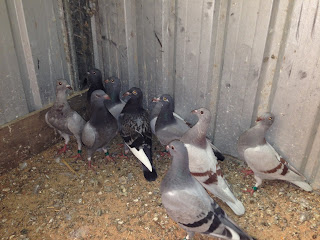One of the frequently ignored parts of
pigeon keeping is the cleanliness of your pigeons. In this article
we'll take a gander at a truly standard way to clean your pigeon
space area Such as Rest Spots (Perches and Nesting Boxes).
The point of this is to be a beginning
stage, don't hesitate to design your own daily or Weekly practice and
include/change things to suit your Pigeons needs as to Place None
flyers into another section If they are not ok to be let out. Some
breeders Never or seldom let out their Breeders.
1. Allow the Pigeons out for their
Daily Fly and Make it on a day that you Bath them so they can relax
and sit in the sun and spend a few hours out side.
Give the pigeons a chance to Rome out
for a fly and let them return while you're cleaning so they know what
your doing their they love to watch you..
- Scrape and clean out each home from the top perch to the bottom perch as it will drop on the floor.
- Breeding boxes start to finish from the top to the bottom ones.
Clickbank Guide & Tools
Try not to take any alternate routes
with this, illness causing creatures like Mites breed in here just as
your pigeons do!
Make sure to take out the home dishes/
Water Containers and put them to the other side for cleaning. It is a
good idea to soak them in a disinfected bucket and let them soak for
a while.
Scratch out the containers to clear any
droppings, triangle scrubbers are very useful for this as they enable
you to put the scrubber appropriate to the back of the case and draw
forward in one movement straight into a receptacle. Do likewise with
perches.
3. Scratch the floor area if you need
to as other parasites do breed on the dropping and feathers on the
ground.
Presently observe to the segment and
passage floors, scratch away any droppings. Utilize a long handle
scrubber to spare your back.
4. Hoover (Vacuum) (once a month) This
is to Get most of the Lint Fluff small feathers or Flakes off the
ground with the dust.
Utilizing a hoover circumvent the
floor, dividers, boxes, and any surfaces, searching for residue, hard
droppings, bits of plumes, webs and so forth, get everything straight
out with the hoover. At the point when the space is exceptionally
dusty the exact opposite thing you need to do is catch up on every
one of the particles into the air. Depending on what number of
pigeons you have you may choose to do this fair once/two times per
month.
5. Clean ( Every Week or Two) This All
Depends How Large You Loft Is.
The following thing is to sterilize the
your loft. Stir up some disinfectant, for example, Disinfectant and
utilizing it in a spry bottle 5-10 liters would be ideal, Give the
Breeding boxes, Perches, floors and even divided and good Spray and
make sure they are wet.. Try to evan it out and you need an even coat
all through.
Leave that to absorb and get dry. Once
more, this should be possible once/two times per month in many cases.
6. Light Cleaning (Once Per Week) This
will make it easy for the big clean.
Once you have disinfected the Breeding
Boxes and your Perches Scrap off the soggy and wet dropping,and ready
to place it in a bag for disposal. May it be in the Bin or Garden.
Be mindful Not to breath in any vapors,
It is advisable to wear a mask as they are a cheap in your hardware
as like Bunning's.
 7. Treatment and Extra cover( 3-4
Months Apply treatment for Mites and any other bugs that may come
around I use Mellow-wash or another strong Insecticide. Same as the
Disinfectant Leave to dry well Before returning the Pigeons Back into
the Loft.
7. Treatment and Extra cover( 3-4
Months Apply treatment for Mites and any other bugs that may come
around I use Mellow-wash or another strong Insecticide. Same as the
Disinfectant Leave to dry well Before returning the Pigeons Back into
the Loft.
At long last, since the space is
spotless, circulated and the Pesticide is Sprayed, You Can also use
Kerosene for a long lasting effect on the off chance treatment may be
placed down and tenderly brush it on. This stuff resembles a baby
powder disinfectant and just keeps things dry while forestalling the
spread of microorganisms.
If your Not Sure on Step 7 Please Don't Use it. I am Sure I have Done This for Years.
8. Last but not least after waiting a
few hours Let your Pigeons Back into their freshly Cleaned Loft.














